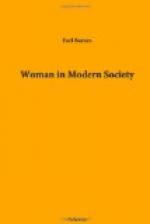Among domesticated animals, where their working possibilities have been very highly developed, females are much more desirable workers than males. The maternal function partly explains this, as in the case of cows and hens which give us milk and eggs; and even with mares and sheep the offspring adds to the general working value. Still, it seems to be true that even for purposes of draught, the males are of less value than the females, unless reduced to the non-sexual condition of geldings and oxen. The stallion, bull or ram is too katabolic, too much of a consuming, distributing, destroying force to be very valuable in the daily routine of agriculture or commerce. While the female is generally smaller and less powerful than the male, she is quiet, easily enslaved; and, as we have said, her maternal functions can be diverted to our daily use. She produces more workers, and her flesh is more palatable, because less distinctive, than that of the male. Hence, among domesticated animals, selection, based on considerations of work, multiplies females and keeps males only for breeding purposes.
As a quadruped, the female suffers very little handicap from the functions peculiar to her sex, except when actually carrying her young or nursing them. When she stands erect, however, the support for the special organs of reproduction is far from ideal; heavy lifting, or long-continued standing, often leads to disaster, and the periodic functions, even in the healthiest conditions, must always place women at a working disadvantage as compared with men. Add to this the fact that women are smaller, less agile, and far less strong, than men, and, even when not encumbered with young, it is clear that a woman, when confronting physical work in competition with men, needs something more than a fair field and free competition.[33] Idealists and travelers among primitive people love to tell us how easily women meet their special functions, carrying burdens equal to those carried by men when on the march, and dropping out from the caravan for only a few hours to give birth to a child; but the fact remains that women in all primitive societies age quickly and that those who are spoiled are thrown aside and forgotten.[34] Woman’s handicap as a working animal in competition with man is too obvious and too deep-seated to be idealized away.
[33] The Supreme Court of the United States, in passing on the “Oregon laundry case,” in 1907, declared a bill limiting a woman’s working hours constitutional. See the Brief for the State of Oregon, prepared by LOUIS D. BRANDEIS, published by The National Consumers’ League, 105 East 22d Street, New York.
[34] DUDLEY, Principles and Practices of Gynecology, pp. 23-24, says that among Indian women want of care during and after labor leads to numberless evils.




